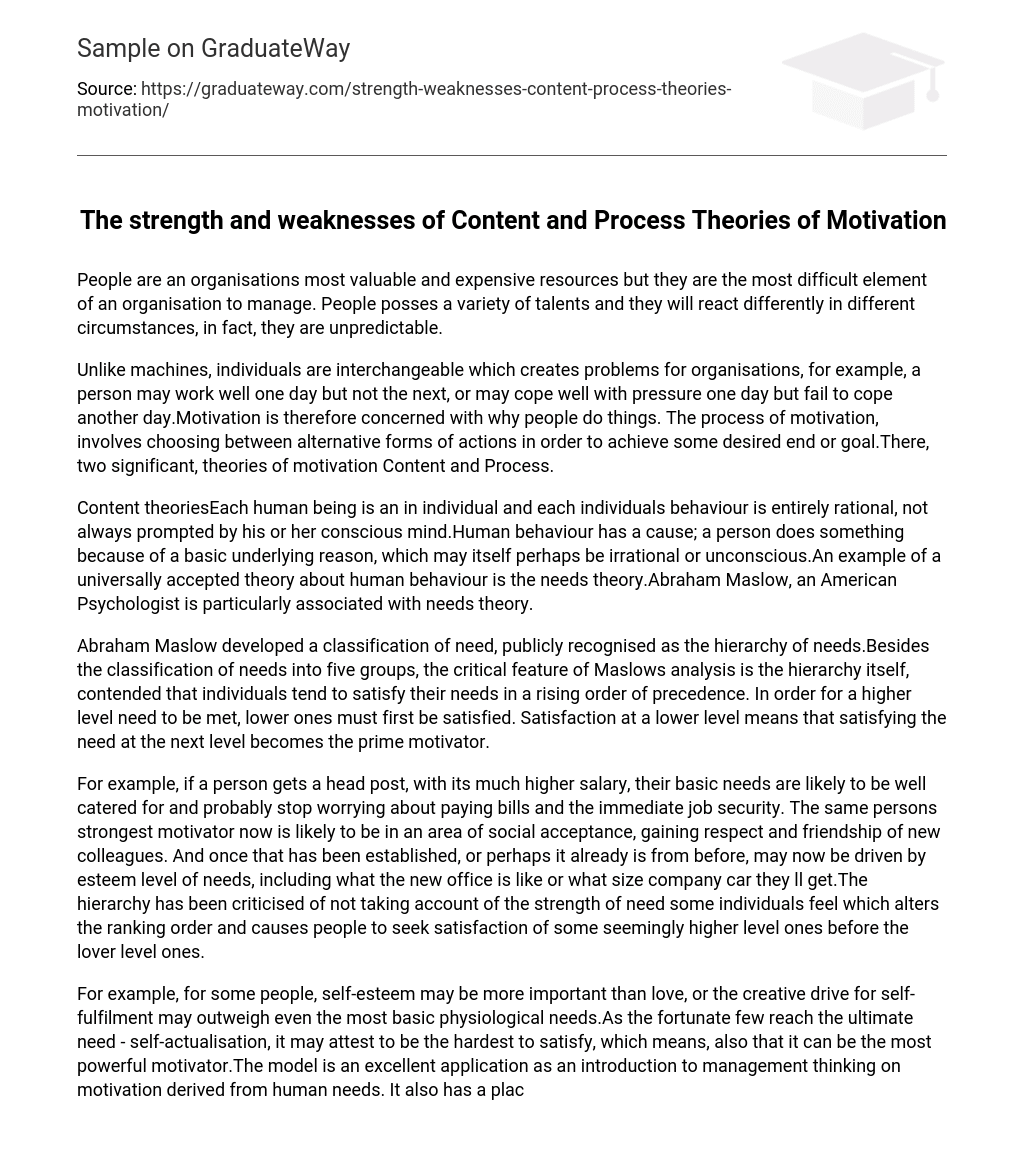People are an organisations most valuable and expensive resources but they are the most difficult element of an organisation to manage. People posses a variety of talents and they will react differently in different circumstances, in fact, they are unpredictable.
Unlike machines, individuals are interchangeable which creates problems for organisations, for example, a person may work well one day but not the next, or may cope well with pressure one day but fail to cope another day.Motivation is therefore concerned with why people do things. The process of motivation, involves choosing between alternative forms of actions in order to achieve some desired end or goal.There, two significant, theories of motivation Content and Process.
Content theoriesEach human being is an in individual and each individuals behaviour is entirely rational, not always prompted by his or her conscious mind.Human behaviour has a cause; a person does something because of a basic underlying reason, which may itself perhaps be irrational or unconscious.An example of a universally accepted theory about human behaviour is the needs theory.Abraham Maslow, an American Psychologist is particularly associated with needs theory.
Abraham Maslow developed a classification of need, publicly recognised as the hierarchy of needs.Besides the classification of needs into five groups, the critical feature of Maslows analysis is the hierarchy itself, contended that individuals tend to satisfy their needs in a rising order of precedence. In order for a higher level need to be met, lower ones must first be satisfied. Satisfaction at a lower level means that satisfying the need at the next level becomes the prime motivator.
For example, if a person gets a head post, with its much higher salary, their basic needs are likely to be well catered for and probably stop worrying about paying bills and the immediate job security. The same persons strongest motivator now is likely to be in an area of social acceptance, gaining respect and friendship of new colleagues. And once that has been established, or perhaps it already is from before, may now be driven by esteem level of needs, including what the new office is like or what size company car they ll get.The hierarchy has been criticised of not taking account of the strength of need some individuals feel which alters the ranking order and causes people to seek satisfaction of some seemingly higher level ones before the lover level ones.
For example, for some people, self-esteem may be more important than love, or the creative drive for self-fulfilment may outweigh even the most basic physiological needs.As the fortunate few reach the ultimate need – self-actualisation, it may attest to be the hardest to satisfy, which means, also that it can be the most powerful motivator.The model is an excellent application as an introduction to management thinking on motivation derived from human needs. It also has a place in training programmes for sales personnel, who have to understand the needs of the customer as a first stage in the selling process.
The basic classification has enduring relevance to management today. In particular, it emphasises that incentives to motivate people depends upon their current level of need, satisfaction.Whilst, Maslow attempted to describe motivation in terms of human needs, Herzberg argues different. In the content of management, Maslows work only of value of the work factors involved in the satisfaction of such needs can be identified.
Frederick Herzbergs developed his two factors theory of motivation by looking at various jobs and how they relate to needs.Herzbergs most important contribution is perhaps his assertion that work itself is a potential motivator. He showed that the elements which give most job satisfaction had little to do with money or status, and far more to do with achievement and responsibility within the job. Note in particular that the hygiene factors are those traditionally thought of as motivators.
However, Herzberg saw them as essentially either preventative measures taken to remove sources of dissatisfaction, or actions taken to produce transitory satisfaction. For example, if working conditions improve, or there is a pay increase, immediate dissatisfaction may be alleviated, but feelings of satisfaction are not long lasting. When any of the hygiene factors is deficient people sometimes express their discontent in ways, damaging to the organisation strikes, grievances, go-slows, decreased productivity, etc.The importance of this in a work environment is that managers should ensure that both hygiene factors (pay, working conditions, etc.
roughly equating with Maslows levels 1 and 2) and motivating factors (need for personal fulfilment Maslows level 4 and 5) are satisfied if employees are to be both contented and motivated.Whilst, the needs theories tries to identify the integral desires that influence behaviour; they are concerned with the nature and context of motivating factors. By contrast Process theories, concentrate on elucidating the thought processes through which individuals determine their own cause of action.Vrooms expectancy theory, 1964, suggests that people are not necessarily motivated by internal needs, but more by the expectation that certain actions will achieve an outcome seem by them as desirable.
He argues that employees perform well when they can see a connection between effort, performance and reward. In theory, extra effort will lead to better performance, and job performance will lead to outcomes such as promotion, extra responsibility and more pay.





